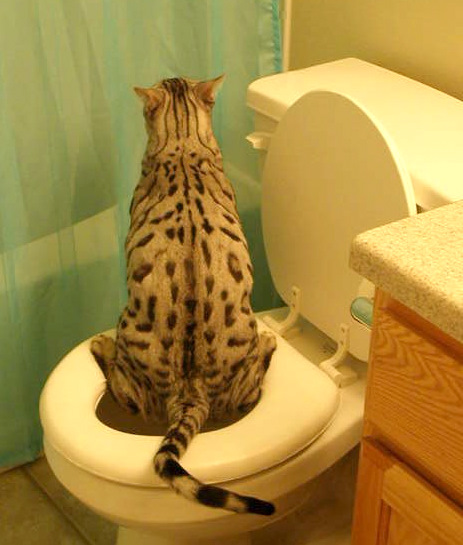Prevent Bathroom Emergencies: Don't Flush Cat Poop Down Your Toilet - Expert Guidance
Prevent Bathroom Emergencies: Don't Flush Cat Poop Down Your Toilet - Expert Guidance
Blog Article
This great article listed below about Can You Flush Cat Poop Down The Toilet? is fairly stimulating. Don't miss it.

Intro
As pet cat owners, it's essential to be mindful of how we throw away our feline friends' waste. While it might appear practical to purge feline poop down the bathroom, this technique can have destructive repercussions for both the atmosphere and human health and wellness.
Environmental Impact
Flushing feline poop presents damaging microorganisms and parasites right into the water, positioning a significant risk to aquatic ecosystems. These pollutants can adversely impact aquatic life and concession water high quality.
Wellness Risks
In addition to ecological worries, purging feline waste can additionally pose health and wellness risks to people. Pet cat feces might contain Toxoplasma gondii, a bloodsucker that can create toxoplasmosis-- a possibly severe health problem, especially for pregnant women and individuals with weakened body immune systems.
Alternatives to Flushing
Luckily, there are safer and much more responsible methods to deal with feline poop. Think about the complying with alternatives:
1. Scoop and Dispose in Trash
One of the most common approach of getting rid of cat poop is to scoop it into a biodegradable bag and toss it in the trash. Be sure to use a dedicated litter scoop and throw away the waste immediately.
2. Use Biodegradable Litter
Opt for biodegradable feline litter made from materials such as corn or wheat. These clutters are environmentally friendly and can be safely disposed of in the garbage.
3. Hide in the Yard
If you have a backyard, think about hiding pet cat waste in a designated area far from veggie gardens and water resources. Make certain to dig deep sufficient to prevent contamination of groundwater.
4. Install a Pet Waste Disposal System
Invest in an animal garbage disposal system specifically created for pet cat waste. These systems make use of enzymes to break down the waste, minimizing smell and ecological influence.
Final thought
Responsible family pet possession extends beyond supplying food and shelter-- it also involves proper waste monitoring. By avoiding flushing cat poop down the bathroom and selecting different disposal techniques, we can decrease our ecological footprint and safeguard human health.
Why Can’t I Flush Cat Poop?
It Spreads a Parasite
Cats are frequently infected with a parasite called toxoplasma gondii. The parasite causes an infection called toxoplasmosis. It is usually harmless to cats. The parasite only uses cat poop as a host for its eggs. Otherwise, the cat’s immune system usually keeps the infection at low enough levels to maintain its own health. But it does not stop the develop of eggs. These eggs are tiny and surprisingly tough. They may survive for a year before they begin to grow. But that’s the problem.
Our wastewater system is not designed to deal with toxoplasmosis eggs. Instead, most eggs will flush from your toilet into sewers and wastewater management plants. After the sewage is treated for many other harmful things in it, it is typically released into local rivers, lakes, or oceans. Here, the toxoplasmosis eggs can find new hosts, including starfish, crabs, otters, and many other wildlife. For many, this is a significant risk to their health. Toxoplasmosis can also end up infecting water sources that are important for agriculture, which means our deer, pigs, and sheep can get infected too.
Is There Risk to Humans?
There can be a risk to human life from flushing cat poop down the toilet. If you do so, the parasites from your cat’s poop can end up in shellfish, game animals, or livestock. If this meat is then served raw or undercooked, the people who eat it can get sick.
In fact, according to the CDC, 40 million people in the United States are infected with toxoplasma gondii. They get it from exposure to infected seafood, or from some kind of cat poop contamination, like drinking from a stream that is contaminated or touching anything that has come into contact with cat poop. That includes just cleaning a cat litter box.
Most people who get infected with these parasites will not develop any symptoms. However, for pregnant women or for those with compromised immune systems, the parasite can cause severe health problems.
How to Handle Cat Poop
The best way to handle cat poop is actually to clean the box more often. The eggs that the parasite sheds will not become active until one to five days after the cat poops. That means that if you clean daily, you’re much less likely to come into direct contact with infectious eggs.
That said, always dispose of cat poop in the garbage and not down the toilet. Wash your hands before and after you clean the litter box, and bring the bag of poop right outside to your garbage bins.
https://trenchlesssolutionsusa.com/why-cant-i-flush-cat-poop/

I hope you liked our topic about How to Dispose of Cat Poop and Litter Without Plastic Bags. Thanks for spending some time to read our posting. Are you aware of somebody else who is intrigued by the topic? Please feel free to promote it. Thanks for your time. Don't forget to check up our blog back soon.
Maintenance Sign-Up Report this page